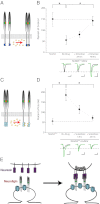Dimerization of postsynaptic neuroligin drives synaptic assembly via transsynaptic clustering of neurexin
- PMID: 23129658
- PMCID: PMC3511127
- DOI: 10.1073/pnas.1217633109
Dimerization of postsynaptic neuroligin drives synaptic assembly via transsynaptic clustering of neurexin
Abstract
The transsynaptic complex of neuroligin (NLGN) and neurexin forms a physical connection between pre- and postsynaptic neurons that occurs early in the course of new synapse assembly. Both neuroligin and neurexin have, indeed, been proposed to exhibit active, instructive roles in the formation of synapses. However, the process by which these instructive roles play out during synaptogenesis is not well understood. Here, we examine one aspect of postsynaptic neuroligin with regard to its synaptogenic properties: its basal state as a constitutive dimer. We show that dimerization is required for the synaptogenic properties of neuroligin and likely serves to induce presynaptic differentiation via a transsynaptic clustering of neurexin. Further, we introduce chemically inducible, exogenous dimerization domains to the neuroligin molecule, effectively bestowing chemical control of neuroligin dimerization. This allows us to identify the acute requirements of neuroligin dimerization by chemically manipulating the monomeric-to-dimeric conversion of neuroligin. Based on the results of the inducible dimerization experiments, we propose a model in which dimerized neuroligin induces the mechanical clustering of presynaptic molecules as part of a requisite step in the coordinated assembly of a chemical synapse.
Conflict of interest statement
The authors declare no conflict of interest.
Figures



Similar articles
-
Neuroligin-1 performs neurexin-dependent and neurexin-independent functions in synapse validation.EMBO J. 2009 Oct 21;28(20):3244-55. doi: 10.1038/emboj.2009.249. Epub 2009 Sep 3. EMBO J. 2009. PMID: 19730411 Free PMC article.
-
Dynamic mechanisms of neuroligin-dependent presynaptic terminal assembly in living cortical neurons.Neural Dev. 2014 May 29;9:13. doi: 10.1186/1749-8104-9-13. Neural Dev. 2014. PMID: 24885664 Free PMC article.
-
The postsynaptic adenomatous polyposis coli (APC) multiprotein complex is required for localizing neuroligin and neurexin to neuronal nicotinic synapses in vivo.J Neurosci. 2010 Aug 18;30(33):11073-85. doi: 10.1523/JNEUROSCI.0983-10.2010. J Neurosci. 2010. PMID: 20720115 Free PMC article.
-
A matter of balance: role of neurexin and neuroligin at the synapse.Neurochem Res. 2013 Jun;38(6):1174-89. doi: 10.1007/s11064-013-1029-9. Epub 2013 Apr 5. Neurochem Res. 2013. PMID: 23559421 Review.
-
Neuroligin-2 as a central organizer of inhibitory synapses in health and disease.Sci Signal. 2020 Dec 22;13(663):eabd8379. doi: 10.1126/scisignal.abd8379. Sci Signal. 2020. PMID: 33443230 Review.
Cited by
-
A Conserved Tyrosine Residue in Slitrk3 Carboxyl-Terminus Is Critical for GABAergic Synapse Development.Front Mol Neurosci. 2019 Sep 10;12:213. doi: 10.3389/fnmol.2019.00213. eCollection 2019. Front Mol Neurosci. 2019. PMID: 31551708 Free PMC article.
-
SALM1 controls synapse development by promoting F-actin/PIP2-dependent Neurexin clustering.EMBO J. 2019 Sep 2;38(17):e101289. doi: 10.15252/embj.2018101289. Epub 2019 Aug 1. EMBO J. 2019. PMID: 31368584 Free PMC article.
-
SNX27-Mediated Recycling of Neuroligin-2 Regulates Inhibitory Signaling.Cell Rep. 2019 Nov 26;29(9):2599-2607.e6. doi: 10.1016/j.celrep.2019.10.096. Cell Rep. 2019. PMID: 31775031 Free PMC article.
-
Molecular Mechanism of MDGA1: Regulation of Neuroligin 2:Neurexin Trans-synaptic Bridges.Neuron. 2017 Jun 21;94(6):1132-1141.e4. doi: 10.1016/j.neuron.2017.06.009. Neuron. 2017. PMID: 28641112 Free PMC article.
-
Regulation of membrane NMDA receptors by dynamics and protein interactions.J Cell Biol. 2021 Jan 4;220(1):e202006101. doi: 10.1083/jcb.202006101. J Cell Biol. 2021. PMID: 33337489 Free PMC article. Review.
References
Publication types
MeSH terms
Substances
Grants and funding
LinkOut - more resources
Full Text Sources
Miscellaneous

